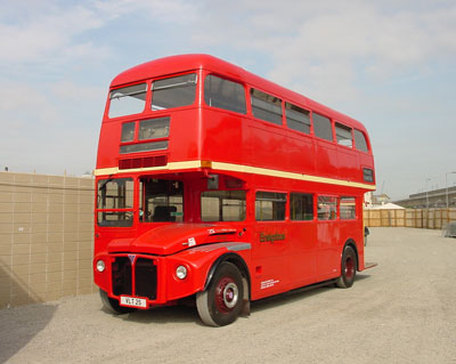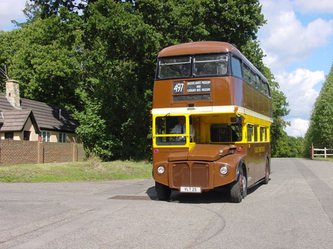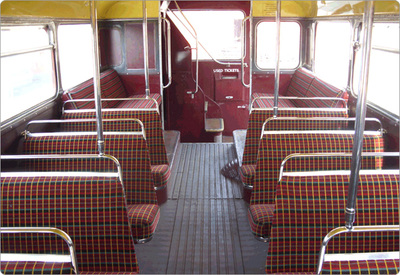Recent Photos
|
Routemaster - RM25
Seating Capacity:
64 (36 upstairs and 28 downstairs) Description:
Being one of the very early RM’s into service in 1959 and not being withdrawn until 2005, this bus can claim a London pedigree few vehicles can rival. In that time having served all over London and from many different garages there is every chance that if you used to travel on a Routemaster you may well have travelled on this one! Having worn a number of liveries in its time, today it has been returned to the red and cream it would’ve worn when new, but now benefiting from upgraded lighting and engine its a reminder of their longevity in London service and of this vehicles particular achievements in that area. Vehicle History
Routemaster Class History:
The Routemaster or RM is without doubt one of the most famous types of bus ever to run in the capital. The original necessity was for vehicles to replace the Trolleybus which was due for replacement in 1959. Following a lot of research it had been decided to increase the capacity of London’s buses from 56, such as the RT, to 64. Following numerous changes and nearly five years of development the RM finally entered service. By 1962 the entire Trolleybus fleet had been replaced almost exclusively by Routemasters. In this period RM8-879 were all built and had entered service. Increasing the length and capacity of the RM was another contentious point, with both the Unions and Met Police being against the idea. However in 1961 a batch of 24, 30’ long 72 seat versions, known as the RML or Routemaster Lengthened, were built to trial. These took the numbers of RML880-904. Following this batch, whilst the trial continued with the longer versions, production continued on the standard length RM producing numbers RM905-1452. The next version was the batch between RMC1453-1520, which were built as Routemaster Coaches (RMC). These had such delights as deeper more comfortable seats, Green Line livery, powered rear doors, twin headlamps and interior luggage racks and were far quicker. Following this batch production again returned to the standard RM which ran through from the number RM1521-2217 which became the very last standard length RM built. Following the success of the RMC’s the next batch to be built, which were by many, seen as the zenith of RM design being the RCL’s. These took the numbers from RCL2218-2260 and were built to replace the Green Line RT’s on the busy (but declining) routes from Essex into Aldgate. Similar in comfort levels to the RMC they were a longer and more powerful version Permission had now been granted to run the longer RML’s in Central London and the final production batch ran from RML2261-2760 were all built to this specification. Two batches of 50 of these RML’s were built for the Country Area and were delivered in Green being RML2306-2355 and RML2411-2460. The final type of RM to enter service with London Transport was the RMA, or Routemaster Airport, version which originally ran for British European Airways bringing passengers to and fro between Central London and Heathrow before the Underground was extended there. The Routemaster was gradually withdrawn from London in the 1980’s before a change of plan saw many of the longer versions (and some standard length ones) be refurbished in 1990-92 when they received new engines, lighting and seating. In 2000-01 some had another refurbishment where they were fitted with more environmentally friendly engines and new gear boxes. However, the policy changed in 2003 and the final 20 routes were given warning that at next change of contract the vehicles required would not be RM’s. One by one these routes were withdrawn with the very last, the 159’s, finishing on December 9, 2005. However, such is the popularity of this type of vehicle that around 16 were retained for use on two heritage routes in Central London. For more on this class why not visit Ian's Bus Stop RM25 RM25 is one of the longest serving London Transport vehicles having first entered service at Willesden Garage for use on the 8’s in July 1959 and lasting through to withdrawal in 2005. Following its pretty brief stay at Willesden, RM25 moved east, heading first to Loughton, before having stints at Poplar, West Ham and later Alperton. Following its final full overhaul at Aldenham in 1983, the bus moved first to Holloway and then Merton, Steatham, Norwood and Brixton. Privatisation would polarise the vehicle within the Cowie, later Arriva, South London fleet, where working on the 159’s she received the red and cream route branding whilst here.In 2002 she wore another special livery, this time the gold to celebrate the Queens Golden Jubilee, before being reinstated back to red the following year. To celebrate the 50th anniversary of the ‘birth’ of the Routemaster RM25 was again selected to wear a special livery, this time a chocolate, white and yellow, representing ‘Great Northern’. She then became a regular performer on many of the Routes last day specials wearing the unusual livery until her own time to be displaced came first from Battersea on the 19’s and then as the 159’s were converted, thus brining to an end a front line London service life of nearly 46 years.Passing to Ensignbus, she was retained in fleet although transferred to the Cardiff depot and returned to the traditional red livery The Cardiff operation was later sold by Ensign in 2010 at which point RM25 was returned to Purfleet where it is now an active vehicle in the Heritage Fleet. Technical Specifications: Date of first registration: July 1959 Chassis: AEC Routemaster Chassis number: RM 25 Engine: Scania D9 Fuel: Diesel Chassis/Body Code: 4/5RM5/4 Body: Park Royal Body Number: B1138 Seating: 64 seats (36 upstairs & 28 downstairs) |











